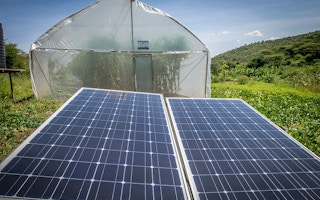Staff of the International Center of Insect Physiology and Ecology (ICIPE) don’t worry too much about the frequent power outages at their campuses. A bank of diesel generators ensure that when power from the national grid goes off, the centre’s research into insects, food and health is not disrupted.
But the five generators at ICIPE’s Homa Bay centre, on the shore of Lake Victoria in south-west Kenya, cost about $4,000 a year to fuel and maintain - and they contribute to climate change.
Now the campus is set to bid farewell to two of its five generators by the end of the year as a solar battery system comes into operation to provide electric power to the centre at night.
The system, which is currently under construction, will use 144 batteries to store electricity generated by 744 solar panels.
The batteries will provide up to five hours of power each night. After that, the centre will rely on electric grid power - or the three remaining diesel generators in case of a blackout.
This is the first time that solar batteries have been installed in a large commercial utility in Kenya, according to Solarcentury, the solar power company that is installing them.
Solarcentury, whose parent company is based in the UK, is also installing 3,460 solar panels at ICIPE’s Nairobi campus. The Nairobi system is also due to come online by the end of the year.
“
Despite the high cost of installation, the use of solar systems with battery storage is not only environmentally friendly but also economical in the long run.
Gatigwa Kimana, director of finance, International Center of Insect Physiology and Ecology
Together, the two solar battery systems, which cost a total of $2.5 million, will generate a peak output of 1,154 kilowatts.
Gatigwa Kimana, ICIPE’s director of finance, said that the centre wanted to find a clean, reliable and renewable energy source as part of an initiative launched last year to use green energy and conserve water.
ICIPE has been using diesel generators as its only power backup since its inception 40 years ago.
“The costs of lost opportunities in the event of a power blackout is higher than the monetary costs of purchasing of diesel,” Kinama explained. “After a feasibility study was conducted, we decided on solar energy, in line with our philosophy to conserve the environment.”
ICIPE hopes to extend its system at Homa Bay next year to provide all-night power from the solar batteries.
“Despite the high cost of installation, the use of solar systems with battery storage is not only environmentally friendly but also economical in the long run,” said Guy Lawrence, Solarcentury’s East Africa director.
Parking lot solar
Lawrence noted that since Solarcentury began operating in Kenya three years ago, its three other corporate clients have chosen a relatively cheaper hybrid system rather than opting for battery storage.
Hybrid systems combine solar and other power sources the client already is using. In the case of Garden City, a big mall east of Nairobi, a solar panel system has been integrated with power from the national grid and from diesel generators.
The mall boasts the biggest solar car parking lot in East Africa, with 3,500 solar panels installed on shade structures over parking spaces. The panels produce 915 kilowatts of power.
“The idea of installing the solar panels on the rooftop is for practicality, whereby cars are protected from rain and sun and other environmental elements while supplying power,” said Lawrence.
The mall now uses solar energy during the day and switches to the power from the national grid at night.
Lawrence sees the market for solar panels and battery systems growing after other potential users get a look at the early projects.
“The level of interest and the number of contracts we are signing are growing exponentially,” he said, with interest from businesses including agricultural producers and manufacturing firms.
Apart from the private sector, the government is also taking strides to bring more solar power into the national power grid. The Ministry of Energy called for proposals to install solar systems with battery storage early this year.
The government, through the Rural Electrification Authority, a public corporation, has also begun building a 55-megawatt solar power plant in sun-rich Garissa, in the north-east of the country.
This story was published with permission from Thomson Reuters Foundation, the charitable arm of Thomson Reuters, that covers humanitarian news, climate change, women’s rights, trafficking and property rights. Visit http://news.trust.org/climate.










